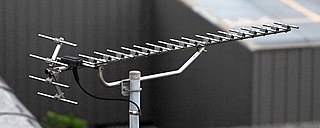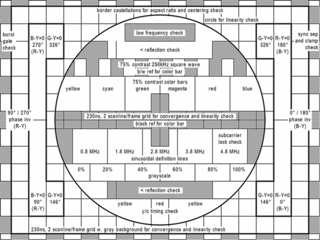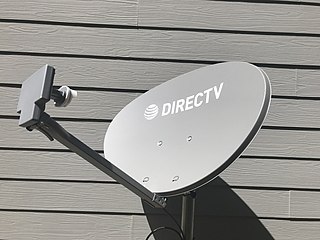Related Research Articles

Microwave is a form of electromagnetic radiation with wavelengths ranging from about one meter to one millimeter corresponding to frequencies between 300 MHz and 300 GHz respectively. Different sources define different frequency ranges as microwaves; the above broad definition includes both UHF and EHF bands. A more common definition in radio-frequency engineering is the range between 1 and 100 GHz. In all cases, microwaves include the entire SHF band at minimum. Frequencies in the microwave range are often referred to by their IEEE radar band designations: S, C, X, Ku, K, or Ka band, or by similar NATO or EU designations.

Very high frequency (VHF) is the ITU designation for the range of radio frequency electromagnetic waves from 30 to 300 megahertz (MHz), with corresponding wavelengths of ten meters to one meter. Frequencies immediately below VHF are denoted high frequency (HF), and the next higher frequencies are known as ultra high frequency (UHF).
The Ku band is the portion of the electromagnetic spectrum in the microwave range of frequencies from 12 to 18 gigahertz (GHz). The symbol is short for "K-under", because it is the lower part of the original NATO K band, which was split into three bands because of the presence of the atmospheric water vapor resonance peak at 22.24 GHz, (1.35 cm) which made the center unusable for long range transmission. In radar applications, it ranges from 12 to 18 GHz according to the formal definition of radar frequency band nomenclature in IEEE Standard 521-2002.

Ultra high frequency (UHF) is the ITU designation for radio frequencies in the range between 300 megahertz (MHz) and 3 gigahertz (GHz), also known as the decimetre band as the wavelengths range from one meter to one tenth of a meter. Radio waves with frequencies above the UHF band fall into the super-high frequency (SHF) or microwave frequency range. Lower frequency signals fall into the VHF or lower bands. UHF radio waves propagate mainly by line of sight; they are blocked by hills and large buildings although the transmission through building walls is strong enough for indoor reception. They are used for television broadcasting, cell phones, satellite communication including GPS, personal radio services including Wi-Fi and Bluetooth, walkie-talkies, cordless phones, and numerous other applications.

Amateur television (ATV) is the transmission of broadcast quality video and audio over the wide range of frequencies of radio waves allocated for radio amateur (Ham) use. ATV is used for non-commercial experimentation, pleasure, and public service events. Ham TV stations were on the air in many cities before commercial television stations came on the air. Various transmission standards are used, these include the broadcast transmission standards of NTSC in North America and Japan, and PAL or SECAM elsewhere, utilizing the full refresh rates of those standards. ATV includes the study of building of such transmitters and receivers, and the study of radio propagation of signals travelling between transmitting and receiving stations.
The L band is the Institute of Electrical and Electronics Engineers (IEEE) designation for the range of frequencies in the radio spectrum from 1 to 2 gigahertz (GHz).
The S band is a designation by the Institute of Electrical and Electronics Engineers (IEEE) for a part of the microwave band of the electromagnetic spectrum covering frequencies from 2 to 4 gigahertz (GHz). Thus it crosses the conventional boundary between the UHF and SHF bands at 3.0 GHz. The S band is used by airport surveillance radar for air traffic control, weather radar, surface ship radar, and some communications satellites, especially those used by NASA to communicate with the Space Shuttle and the International Space Station. The 10 cm radar short-band ranges roughly from 1.55 to 5.2 GHz. The S band also contains the 2.4–2.483 GHz ISM band, widely used for low power unlicensed microwave devices such as cordless phones, wireless headphones (Bluetooth), wireless networking (WiFi), garage door openers, keyless vehicle locks, baby monitors as well as for medical diathermy machines and microwave ovens. India's regional satellite navigation network (IRNSS) broadcasts on 2.483778 to 2.500278 GHz.
The X band is the designation for a band of frequencies in the microwave radio region of the electromagnetic spectrum. In some cases, such as in communication engineering, the frequency range of the X band is rather indefinitely set at approximately 7.0–11.2 GHz. In radar engineering, the frequency range is specified by the Institute of Electrical and Electronics Engineers (IEEE) as 8.0–12.0 GHz. The X band is used for radar, satellite communication, and wireless computer networks.
The radio spectrum is the part of the electromagnetic spectrum with frequencies from 30 Hz to 300 GHz. Electromagnetic waves in this frequency range, called radio waves, are widely used in modern technology, particularly in telecommunication. To prevent interference between different users, the generation and transmission of radio waves is strictly regulated by national laws, coordinated by an international body, the International Telecommunication Union (ITU).
Extremely high frequency (EHF) is the International Telecommunication Union (ITU) designation for the band of radio frequencies in the electromagnetic spectrum from 30 to 300 gigahertz (GHz). It lies between the super high frequency band and the far infrared band, the lower part of which is the terahertz band. Radio waves in this band have wavelengths from ten to one millimetre, so it is also called the millimetre band and radiation in this band is called millimetre waves, sometimes abbreviated MMW or mmWave. Millimetre-length electromagnetic waves were first investigated by Indian physicist Jagadish Chandra Bose during 1894–1896, when he reached up to 60 GHz in his experiments.
Amateur radio frequency allocation is done by national telecommunication authorities. Globally, the International Telecommunication Union (ITU) oversees how much radio spectrum is set aside for amateur radio transmissions. Individual amateur stations are free to use any frequency within authorized frequency ranges; authorized bands may vary by the class of the station license.

Satellite television is a service that delivers television programming to viewers by relaying it from a communications satellite orbiting the Earth directly to the viewer's location. The signals are received via an outdoor parabolic antenna commonly referred to as a satellite dish and a low-noise block downconverter.

Radio is the technology of signaling and communicating using radio waves. Radio waves are electromagnetic waves of frequency between 30 hertz (Hz) and 300 gigahertz (GHz). They are generated by an electronic device called a transmitter connected to an antenna which radiates the waves, and received by another antenna connected to a radio receiver. Radio is very widely used in modern technology, in radio communication, radar, radio navigation, remote control, remote sensing, and other applications.
The 13 centimeter, 2.3 GHz or 2.4 GHz band is a portion of the UHF (microwave) radio spectrum internationally allocated to amateur radio and amateur satellite use on a secondary basis. The amateur radio band is between 2300 MHz and 2450 MHz, and thereby inside the S-band. The amateur satellite band is between 2400 MHz and 2450 MHz, and its use by satellite operations is on a non-interference basis to other radio users. The license privileges of amateur radio operators include the use of frequencies and a wide variety of modes within these ranges for telecommunication. The allocations are the same in all three ITU Regions.
The 1.2-centimeter or 24 GHz band is a portion of the SHF (microwave) radio spectrum internationally allocated to amateur radio and amateur satellite use. The amateur radio band is between 24.00 GHz and 24.25 GHz, and the amateur satellite band is between 24.00 GHz and 24.05 GHz. Amateurs operate on a primary basis between 24.00 GHz and 24.05 GHz and on a secondary basis in the rest of the band. Amateur stations must accept harmful interference from ISM users. The allocations are the same in all three ITU regions.
The 4-millimeter band is a portion of the EHF (microwave) radio spectrum internationally allocated to amateur radio and amateur satellite use. The band is between 75.5 GHz and 81.5 GHz, with some regional and national variations.
The 9-centimeter band is a portion of the SHF (microwave) radio spectrum internationally allocated to amateur radio and amateur satellite use. The amateur radio band, in ITU regions 1 and 2, is between 3,300 MHz and 3,500 MHz, and it is available only on a secondary basis. The amateur satellite band is between 3,400 MHz and 3,410 MHz, and it is only available in ITU Regions 1 and 2, on a non-interference basis to other users. In Germany and Israel, the band 3,400 - 3,475 MHz is also allocated to the amateur service on a secondary basis.

The C band is a designation by the Institute of Electrical and Electronics Engineers (IEEE) for a portion of the electromagnetic spectrum in the microwave range of frequencies ranging from 4.0 to 8.0 gigahertz (GHz); however, this definition is the one used by radar manufacturers and users, not necessarily by microwave radio telecommunications users. The C band is used for many satellite communications transmissions, some Wi-Fi devices, some cordless telephones as well as some surveillance and weather radar systems.
Submillimeter amateur radio refers to Amateur radio activity in the sub-millimeter region of the electromagnetic spectrum. While no international frequency allocations exist for amateur radio in the sub-millimeter region, a number of administrations permit radio amateurs to experiment on Terahertz frequencies. Amateurs who operate in the region must design and construct their own equipment, and those who do, often attempt to set communication distance records on sub-millimeter frequencies.
References
- 1 2 3 "UK BROADCASTING BANDS" (PDF). TheSkywaves.NET. 2003-01-01. Retrieved 2009-05-20.[ permanent dead link ]
- 1 2 "Latest statistics on radio and television broadcasting" (PDF). UNESCO, Division of Statistics on Culture and Communication Office of Statistics. 1987. Retrieved 2009-05-20.
- 1 2 "SATELLITE BROADCASTING: A ZONED REFLECTOR AERIAL FOR THEDOMESTIC RECEPTION OF BAND VI" (PDF). BBC Research & Development. 1972. Retrieved 2009-05-20.
- ↑ "radioastronomy with a small 12GHz satellitedish". Society of Amateur Radio Astronomers. 2008-09-03. Retrieved 2009-05-20.